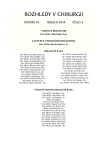-
Medical journals
- Contact
General principles of handling tissues and organs intended for examination in histopathology – pathologists’ requirements for surgeons
Authors: M. Trnková
Authors‘ workplace: BIOLAB Praha, k. s., ředitelka: MUDr. M. Trnková
Published in: Rozhl. Chir., 2014, roč. 93, č. 3, s. 156-163.
Category: Various Specialization
Overview
Histopathology has continued to develop into a complex discipline of laboratory medicine in the last 30 years. Implementation of new techniques such as immunohistochemistry, in situ hybridization, molecular pathology and gene profiling yields a large amount of information which is used not only to establish diagnosis, but also for prediction and prognosis. The basic conditions for precision and correctness of this information which directly influence the choice of therapy and the outcome for the patient, and eventually the health and the life of the patient, are obtaining a suitable specimen and the best laboratory processing. The first step in this procedure is collection of samples, fixation and submission to the pathology laboratory - the pre-analytical phase. Knowledge of the principles of this phase and their implementation in daily practice in surgery is of main importance for the quality and quantity of information obtained. We introduce the basic rules for proper handling of different specimens depending on the use of conventional and “new” histopathology methods.
Key words:
histopathology – pre-examination phase – fixation – handling of specimens
Sources
1. Bancroft DJ, et al. Theory and pracitice of histological techniques. Churchil Livingstone Elsevier, Sixth ed. 2008.
2. Dauendorffer JN, et al. Shrinkage of skin excision specimens: formalin fixation is not the culprit. Br J Dermatol 2009;4 : 810–4.
3. Docquier PL et, al. Formalin fixation could interfere with the clinical assessment of the tumor-free margin in tumor surgery: Magnetic resonance imaging-based study. Oncology 2010;78 : 115–124.
4. Gal AA, et al. The Centennial anniversary of the frozen section technique at the Mayo Clinic. Arch Pathol Lab Med 2005; 129 : 1532–1535.
5. Hewitt SM, et al. Tissue handling and specimen preparation in surgical pathology: issues concerning the recovery of nucleic acids from formalin-fixed, paraffin-embedded tissue. Arch Pathol Lab Med 2008;12 : 1929–35.
6. Jain NJ. Essentials before sending biopsy specimens: A surgeon’s prespective and pathologists concern. Maxillofac Oral Surg 2011;10 : 361–364.
7. Rosai J, et al. The pathology of tumors part II: diagnostic techniques. Cancer J Clin 1979;29 : 22–39.
8. Thompson JF, et al. Cooperation between surgical oncologists and pathologists: a key element of multidisciplinary care for patients with cancer. Pathology 2004;36 : 496?503.
9. Česká technická norma ČSN EN ISO 15189 Zdravotnické laboratoře – Zvláštní požadavky na kvalitu a způsobilost. 2013
Labels
Surgery Orthopaedics Trauma surgery
Article was published inPerspectives in Surgery

2014 Issue 3-
All articles in this issue
- Histopathological differential diagnosis of primary liver tumors
- Organisation and use of a tumour tissue bank
- Injury of the extensor mechanism in the zone I – mallet deformity
- Analysis of complications and clinical and pathologic factors in relation to the laparoscopic cholecystectomy
- Standardization of pancreatic cancer specimen pathological examination
- Transtibial amputation: sagittal flaps in patients with diabetic foot syndrome
- GIST of the small bowel in neurofibromatosis terrain as a source of massive bleeding
- Pathologic fluid collection of mesentery, differential diagnosis of mesenteric cysts – case report
- General principles of handling tissues and organs intended for examination in histopathology – pathologists’ requirements for surgeons
- Lymphatic metastasizing – viewed by pathologist
- Perspectives in Surgery
- Journal archive
- Current issue
- Online only
- About the journal
Most read in this issue- Lymphatic metastasizing – viewed by pathologist
- Pathologic fluid collection of mesentery, differential diagnosis of mesenteric cysts – case report
- Transtibial amputation: sagittal flaps in patients with diabetic foot syndrome
- Injury of the extensor mechanism in the zone I – mallet deformity
Login#ADS_BOTTOM_SCRIPTS#Forgotten passwordEnter the email address that you registered with. We will send you instructions on how to set a new password.
- Contact

